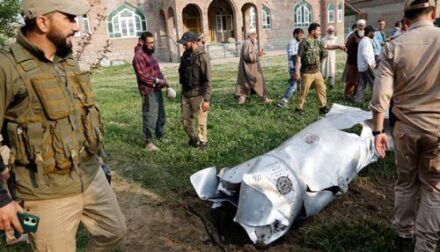By S.M. Hali
In the volatile theatre of South Asian security, India’s persistent ambition to assert conventional military dominance beneath the nuclear threshold is not only strategically flawed—it borders on dangerous delusion.
The Myth of Conventional Superiority
India’s military doctrine has long emphasized the need to maintain overwhelming conventional capabilities vis-à-vis Pakistan. From the Cold Start doctrine to recent surgical strikes and missile tests, New Delhi has sought to project a posture of rapid, punitive retaliation that remains below the nuclear redline. Yet this notion—of a controllable, sub-nuclear conflict—is a strategic mirage.
Despite India’s larger military budget and expanding arsenal, the reality is more nuanced. As recent analyses show, India continues to struggle to establish credible conventional deterrence against Pakistan. The Kargil War of 1999, initiated by Pakistan’s covert incursion, which India responded to conventionally, without crossing the nuclear threshold—underscoring restraint on both sides. Operation Parakram (2001–2002), a massive Indian mobilization following the Parliament attack, failed to achieve its objectives and instead highlighted the dangers of brinkmanship. During the 10-month standoff India suffered over 1,000 troop casualties (mostly non-combat) and failed to achieve strategic objectives, reinforcing the futility of prolonged mobilization under nuclear overhang.
India’s assumption that it can punish Pakistan conventionally without triggering nuclear escalation ignores the doctrinal asymmetry between the two states. Pakistan’s full-spectrum deterrence, backed by tactical nuclear weapons, is designed precisely to neutralize India’s conventional advantage. Any incursion—even a limited one—risks crossing thresholds that are fluid and asymmetrical.
Doctrinal Divergence: Deterrence vs. Delusion
India’s nuclear doctrine is built on “no first use” and “credible minimum deterrence,” with a focus on massive retaliation in response to a nuclear strike. Pakistan, by contrast, maintains ambiguity and reserves the right to use nuclear weapons first in response to existential threats—including conventional aggression.
This doctrinal divergence creates a paradox: India’s conventional strikes, intended to remain below the nuclear threshold, may be interpreted by Pakistan as crossing it. In such a scenario, escalation is not a matter of choice—it becomes a matter of survival.
As Lieutenant General A.B. Shivane notes, “The line between nuclear deterrence and the conventional threshold is increasingly being revisited and blurred in contemporary conflicts.” The Ukraine war, with its fusion of conventional and nuclear signalling, offers a sobering parallel. South Asia, with its history of miscalculation and absence of robust crisis management mechanisms, is even more vulnerable.
Strategic Stability: The Pakistani Counterbalance
Pakistan’s deterrence posture is not static—it is adaptive. The development of tactical nuclear weapons, enhanced delivery systems, and second-strike capabilities has created a layered deterrent that complicates India’s calculus. The deployment of Nasr (Hatf-IX) tactical nuclear missiles, for instance, signals Pakistan’s intent to respond swiftly to any conventional incursion.
Moreover, Pakistan’s strategic community understands that deterrence is not merely about weapons—it is about perception, credibility, and signalling. By maintaining ambiguity and demonstrating resolve, Pakistan has effectively disabled India’s ability to operate freely below the nuclear threshold.
This is not escalation—it is equilibrium. As Zulfikar Ali Bhutto famously declared, “We will eat grass, but we will build the bomb.” That resolve, born of existential necessity, continues to shape Pakistan’s strategic posture.
The May 2025 Conflict: A Case Study in Miscalculation
India’s May 2025 missile strikes under Operation Sindoor—launched in response to the Pahalgam terrorist attack—were intended to demonstrate conventional precision and restraint. Yet the conflict quickly escalated into a four-day multi-domain confrontation, with drone battles, airbase attacks, and retaliatory strikes across Punjab and Azad Kashmir.
Despite India’s claims of “non-escalatory” intent, Pakistan interpreted the strikes as a breach of its red lines, prompting Operation Bunyan-un-Marsoos and a rapid military response. The episode underscored the fragility of thresholds and the unpredictability of escalation in a nuclearized environment.
Joseph Nye, the renowned US political scientist, reminds us: ‘To deter, there must be some prospect of use, but easy usability could produce highly immoral consequences.’ Nye’s concept of ‘smart power’—the fusion of hard and soft power into strategic effectiveness—remains relevant. South Asia’s May 2025 conflict is a vivid reminder that conventional action can quickly spiral into strategic instability.
The Role of Emerging Technologies and Global Actors
India’s pursuit of conventional superiority is further complicated by the rise of multi-domain warfare. Cyber capabilities, space assets, and AI-driven surveillance systems have introduced new escalation vectors. The illusion of a clean, limited war is shattered by the reality of interconnected domains.
International actors, too, play a role. The U.S. tilt toward India, the Quad’s strategic posturing, and Western arms transfers embolden New Delhi—but they do not alter the fundamental deterrence equation. Pakistan’s strategic partnership with China, its indigenous defence capabilities, and its diplomatic outreach ensure that it remains a credible counterweight.
Disabling the Illusion: A Strategic Imperative
India must abandon its pursuit of conventional dominance below the nuclear threshold—not because it lacks capability, but because the concept itself is flawed. Strategic stability in South Asia depends not on dominance, but on deterrence, dialogue, and restraint.
Pakistan, for its part, must continue to invest in credible deterrence, enhance crisis communication channels, and engage in strategic signalling that reinforces redlines. The goal is not war—it is the prevention of war.
As Sun Tzu wrote, “The supreme art of war is to subdue the enemy without fighting.” In South Asia, that art lies not in conventional bravado, but in strategic wisdom.
Conclusion: From Illusion to Equilibrium
India’s quest for conventional superiority under the nuclear threshold is a dangerous illusion—one that risks triggering the very escalation it seeks to avoid. Pakistan’s deterrence posture, rooted in credibility and calibrated ambiguity, has effectively disabled this notion.
In a region shadowed by history and haunted by proximity, stability must be built not on myths of dominance, but on mutual recognition of limits. In South Asia, the art of war is not in conquest—but in the wisdom to avoid it.
Author Bio:
Gp. Capt. (R) Sultan M. Hali is a senior defence analyst, columnist, and author. He writes on strategic affairs, regional diplomacy, and national renewal. His work blends historical insight with contemporary policy analysis.




